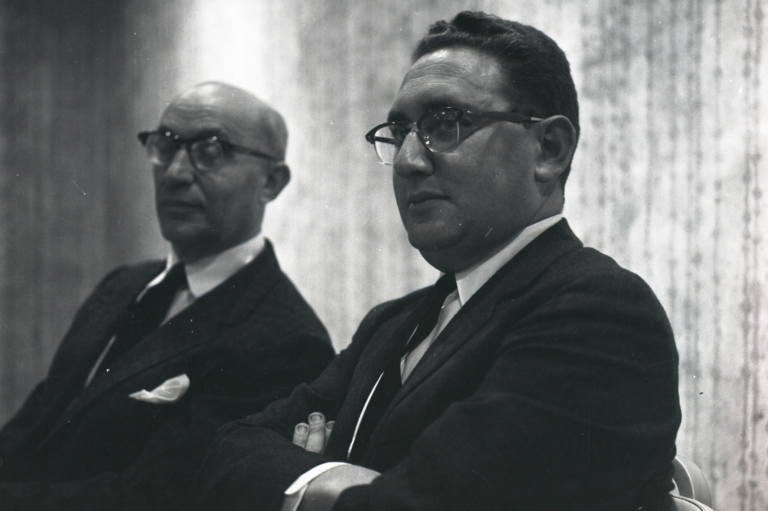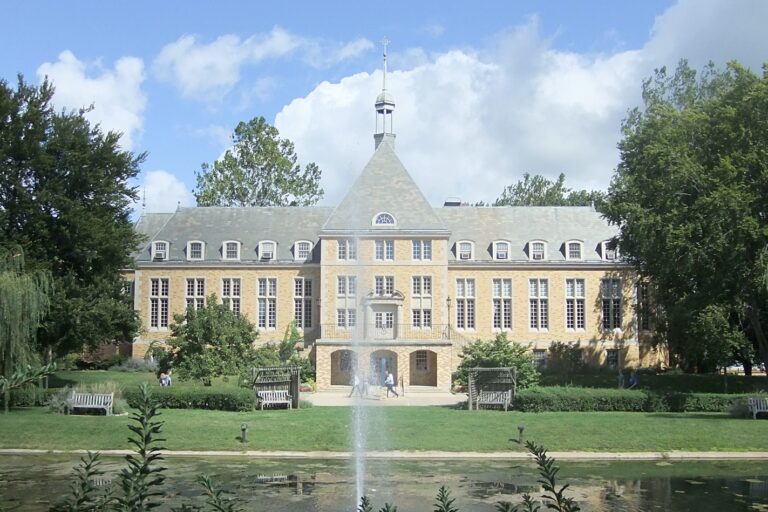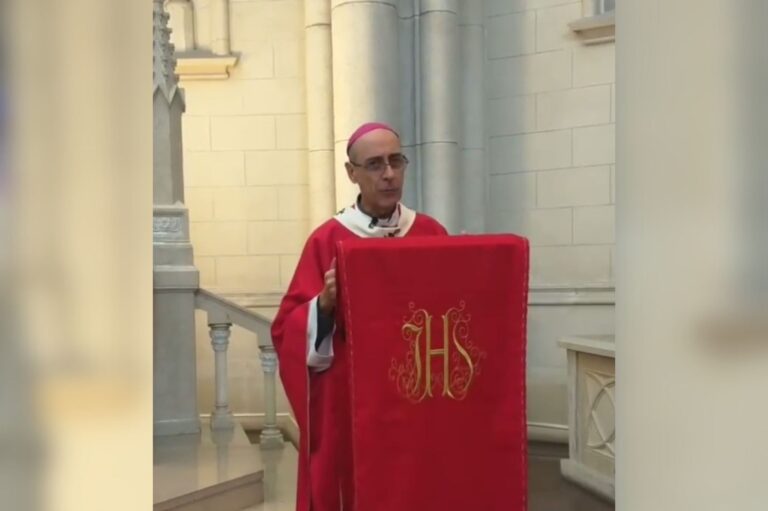The anti-Catholic Left cheered on 15 September 1995 when Peruvian President Alberto Fujimori took to the stage at the United Nation’s Fourth World Conference in Beijing. Here, at last, was a leader of a Latin American country — a Catholic, no less — willing to buck the Vatican’s position on contraception, sterilization and legalized abortion. Claiming the mantle of a “warrior on behalf of the poor,”1 and a visionary in “tennis shoes and blue jeans,”2 the Peruvian President predicted that the debate his government sparked would “extend to other Latin American countries” and that even the Catholic Church would eventually have to “evolve” and “change” on contraceptive issues in response.3 This was heady stuff.
But had the assembled cheerleaders looked a bit more deeply into the Peruvian President’s background they might have re-thought their enthusiasm and muted their applause. Because the battles Fujimori is best known for fighting have not been on behalf of democracy but rather on his own behalf — and a few close associates who allegedly include drug kingpins and death squad leaders. The president’s amenable association with some of Peru’s most hardened thugs and his open contempt of democratic processes and institutions make his willingness to align with international population controllers a frightening prospect. When dictatorial government couples with population control abuses follow, as the last seventeen years of population programing in the People’s Republic of China reveal. Before the world applauds Fujimori’s eagerness to help the poor reduce their number it should reflect on his increasingly autocratic rule
Setting the stage
Fujimori’s connections with the more unsavory members of Peru’s military and intelligence structure date back to 1990. That was the year, according to published accounts, when to many people’s surprise he polled a close second to the presidential front runner, writer Mario Vargas Llosa. Certain elements in the intelligence services set out to co-opt a rising political star. Their opportunity arrived when certain legal problems began to surface in Fujimori’s past.
His most serious problem arose early in the presidential run-off campaign when the candidate of “Honesty, Technology and Work” was revealed to be “pertinaciously fraudulent in underpaying his taxes and undervaluing sales in the real estate business that he operated with his wife.”4 Tellingly, this had been revealed first in intelligence reports and, although touched upon only lightly in the press, the attorney general began preparing a case for prosecution.5 It was at this critical moment the military intelligence organization, known by its Spanish acronym SIN, came to the rescue.
“When Fujimori’s camp despaired of finding a way out, General [Edwin] Diaz ordered [the intelligence services] … to help the afflicted candidate. In a short time more than one witness was persuaded to modify his testimony and the files were fixed by subservient prosecutors.”6
The candidate and his wife Susanna were “more than a little impressed” by the almost miraculous way the military, and in particular a young military official named Vladimiro Montesinos, managed to make their difficult legal problems disappear. They began a relationship which continues to this day. For the rest of the campaign Montesinos delivered the results of secret polls the military had ordered, wiretapping transcriptions and updated intelligence to the Fujimori campaign. Each night before the run-off the two would meet at Fujimori’s sister’s house to review the data and plot political strategy, until Montesinos, gradually, became one of the soon-to-be President’s most influential strategists and advisors — albeit the most secret.7
Peruvian democracy began to suffer at once as a result of this relationship. Immediately after his inauguration as President, Fujimori began to sack people who had opposed Montesinos in the past. These included over 100 police officials who had been the most successful in warring with Peru’s drug organizations, along with General Juan Gambini, the highly efficient anti-drug coordinator. By the end of 1990 “no one dared openly contest Montesinos’ authority in the armed forces or even less so in the police.”8 The stage was set to abort what remained of Peru’s embryonic democracy.
The death of democracy
True Peruvian democracy died on 5 April 1992 when Fujimori dissolved parliament and assumed dictatorial powers. Initially many in Peruvian society applauded the move. After all, hadn’t the country suffered long enough under spiraling inflation and a seemingly intractable insurgency? And wasn’t the legislature feckless, choosing to fiddle while Lima burned? But not everyone agreed.
On the night of 13 November 1992 a group of Peruvian generals mounted a second coup to oust Fujimori and re-assert some of the National Assembly’s power. Although the plotters had most likely been infiltrated by Fujimori supporters, the coup almost succeeded. President Fujimori sought refuge in the Japanese Embassy in Lima while Montesinos and his carefully chosen loyalists coordinated their efforts to keep him in power.9
Whatever remained of the president’s resistance to the dark forces of Peru’s military ended when he walked from his refuge back into the Presidency. Although Fujimori has followed through on his promise to reestablish some measure of democratic rule, it is under a constitution which gives his executive branch and the military a wide range of authority over the legislature and judiciary.”10
The result is a “democracy?’ far more inclined to rubber-stamp whatever the executive desires than to challenge the President’s policies. The consequences of Fujimori’s consolidating his power can be widely demonstrated.
Human rights abuses in Peru
According to the U.S. Department of State and contemporary press accounts, Peru under President Fujimori refuses to recognize human rights as absolutes but treats them instead as relative: that is dependent on class, gender, military or political background and whether one is suspected of any crime.
Much of the responsibility for this attitude toward human rights must be placed at the feet of Montesinos and the other shady characters to whom the President owes so much. But the President, who has come to see his national role as more messianic than political or administrative, must share the blame.11 Peru’s human rights problems include:
Allegations of government involvement in death squad activity. In 1988, 1991 and 1992 extraordinarily brutal massacres of men, women, and even children as young as 8 years old rocked Peru. In each case government and military officials were implicated, both as conspirators and as executioners. The case in 1992 even involved the death-squad’s use of a car owned and registered to President Fujimori’s brother.12 In each instance investigations have been nonexistent, cursory or ended without meaningful prosecutions. Writing about the situation, the U.S. State Department declared in 1993:
“There are only two confirmed cases in which army personnel were convicted for extrajudicial killings. Although the army states there were convictions in four additional cases, it was not possible to verify this as military court records remain under seal.” The same report indicated that even these two examples may be meaningless since one officer sentenced for six years and expulsion from the military for killing civilians remained “free and on active duty.” 13
The government has announced that the inquiries into these questions are closed, though it is unclear whether this persistent stonewalling can make the problem go away.
Allegations of Peruvian women raped while under detention. Feminists and others at the Fourth World Conference on Women would not have applauded Fujimori so loudly had they known that the U.S. State Department, along with Amnesty International and other groups, has credible evidence that Peruvian women were routinely raped by security force personnel when held under “suspicion” of a variety of charges — and that these crimes were occurring even while the president traveled to Beijing.
According to Amnesty International, women prisoners of conscience were being held incommunicado and without trial as late as November 1995. Between 1988 and 1995 at least 4,200 people ‘disappeared’ and thousands more were killed in extrajudicial executions. Amnesty International added in a report issued in November 1995:
“By closing all judicial investigations into such abuses, and pardoning those few members of the security forces serving prison sentences, the government of President Alberto Fujimori has put a question mark around its commitment to uphold human rights.” 14
The U.S, State Department documented the use of rape as a tool of torture against women who were arrested or were merely detained for the length of time it took to rape them, on the suspicion of being supporters of terrorists or other criminals.15
Willingness to detain and even torture medical practitioners. In March 1995, the American Association for the Advancement of Science made public its concern about medical professionals in Peru who were/are being held by the government incommunicado or after very brief trials on the grounds that they supported terrorists or other “enemies” with medical care.
Most of the charges were made by guerillas or former guerrillas who may have been tortured or otherwise influenced in their testimony by a 1994 law which allowed more lenient sentences to those who would name the names of other alleged supporters. Although that law has since been “repealed,” the AAAS still tracks the cases of at least six physicians who are being held and two more who have been sentenced to life terms for their alleged crimes.16
Fujimori: Napoleon in condom?
President Fujimori’s protestations to the contrary, there is no reason to believe, based on current information, that Peru will pursue population control with any greater regard for human rights and liberty than has been the case in China. Neither government can be called a ‘democracy’ in the usual sense of the term. Both governments share an alarming disregard for the human rights of those who are suspected of harboring ill feelings toward the government. Both have abused women and medical personnel in the recent past.
A government which tends to detain, torture, coerce and otherwise mistreat both women and medical personnel should have to earn the trust of the international community before being given any type of international assistance — much less assistance in population control.
Centers of resistance
Right now the only two institutions in Peru in a position to slow a national march toward infertility by decree are the press and the Catholic Church.
Despite threats from the Fujimori government, documented by the U.S. State Department and Amnesty International, media in Peru, especially in Lima, have remained active and freedom of the press has not been infringed upon. However, this could change at any time and cannot be relied upon to hinder Peru’s experiment in population control.
The Catholic Church’s position is both higher profile and more precarious. One writer has noted how, even as early as his second inaugural address, Fujimori began to demonize the Church on the issue of “family planning:”
There was a sudden jolt in the proceedings, however; when extensive family planning was announced, coupled with an attack on ‘sacred cows’ and on people who live in the realm of ideas instead of practicalities. The [State-run] cameras at this point zoomed in on the cardinal and the nuncio who were seated in the galleries.”
At once it was clear that the President was not just saying that the government was concerned about the population explosion and would take measures to reduce it. Rather he was attacking the Church as an institution, ridiculing it as obscurantist, retrograde and partially responsible for the poverty and backwardness in the country. 17
Sources in Peru report that from the time of that speech and Fujimori’s appearance in Beijing the government has confined its population control activities to large-scale advertising campaigns. However, there are also reports of both doctors and medical students being threatened with the loss of their jobs if they decline to sterilize people or insert IUDs. A group of lawyers is working to protect the rights of medical workers by drafting a new law, but since the national legislature is weak and Fujimori-dominated passage seems unlikely.
Clearly Fujimori has mounted the first campaign in his war on Peru’s poor. There is no way to tell precisely how far he is prepared to go. One prominent Peruvian publication has already reported that a joint government-military policy paper calls for “eliminating the social surplus,”18 that is, the poor. Eliminating Peru’s population control funding immediately might save thousands from the wave of human rights violations that is sure to come. —PRI—
Endnotes
1 San Jose Mercury News, 16 September 1995.
2 Alberto Fujimori before the Fourth United Nations Conference on Women, 15 September 1995.
3 Alberto Fujimori interview with Associated Press, 13 September 1995.
4 Gustavo Gorriti. “Fujimori’s Svengali: The Betrayal of Peruvian Democracy,” Covert Action Quarterly, September 1994.
5 Ibid.
6 Ibid.
7 Ibid.
8 Ibid.
9 Gorriti, op. cit.
10 “Peru: Human Rights Practices, 1993,” U.S. Department of State
11 “Alberto Fujimori interview with Associated Press, 13 September 1995.
12 Gorriti, op. cit.
13 U.S . State Department op cit.
14 “Peru: Women’s Rights in Jeopardy,” Amnesty International 8 November 1995.
15 U.S. Department of State op cit.
16 American Association for Advancement of Science Human Rights Action Network, Report, 13 March 1995.
17 Michael Garnett “A Napoleon for Peru” The Tablet, 26 August 1995.










